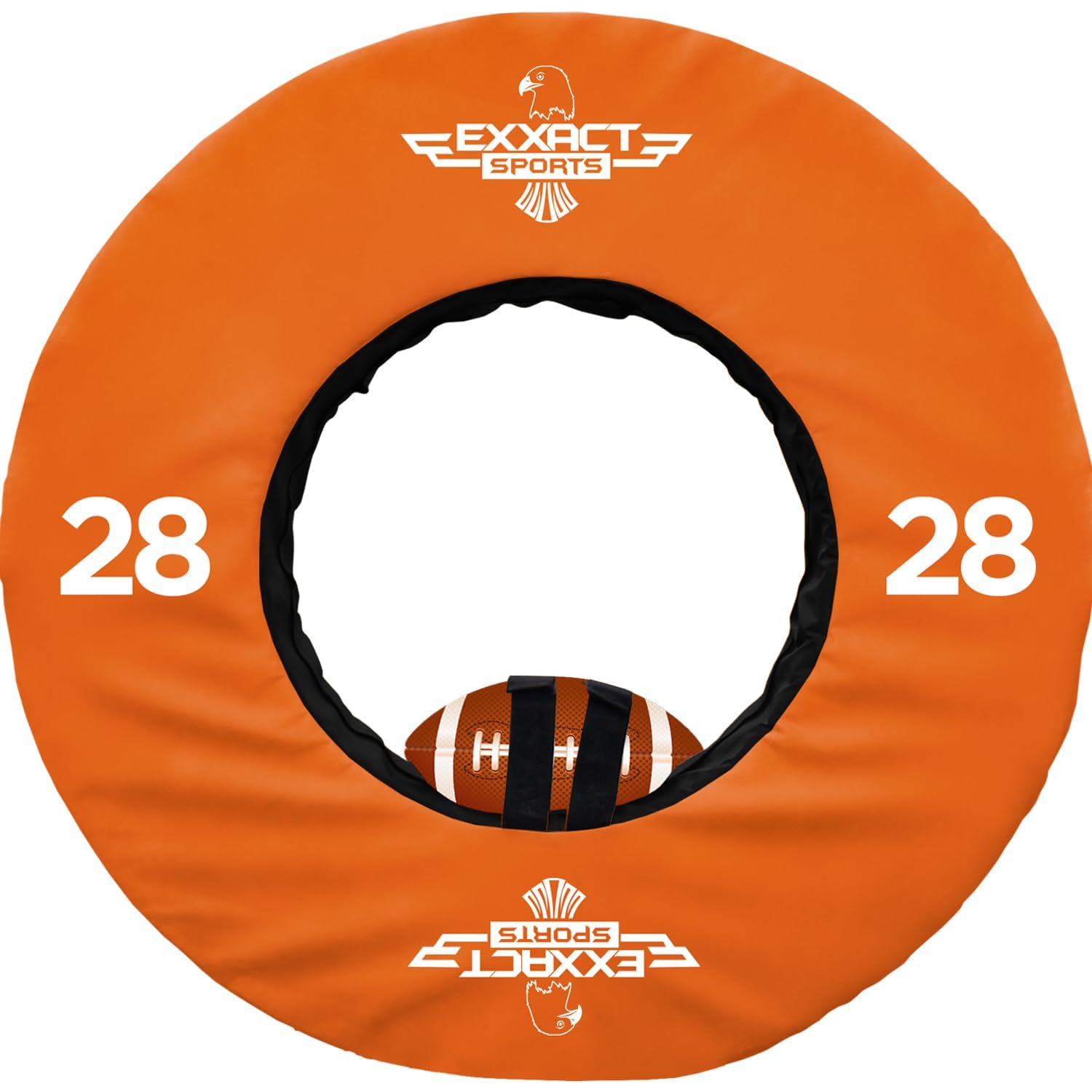Are you a football player looking to improve your tackle technique and shoulder leverage? If so, then you need to get yourself a set of football tackle wheels. These versatile training tools are a great way to develop the strength and coordination you need to make bone-crushing tackles on the field. In this article, we’ll show you how to choose the best tackle wheels, demonstrate leverage drills to improve your tackle technique, and provide tips for maintaining and storing your tackle wheels. We’ll also share some additional drills to improve your football skills and answer some frequently asked questions. So, grab your football and a set of tackle wheels, and let’s get started.
How to choose the best tackle wheels
Choosing the right football tackle wheels is essential for maximizing your training experience and improving your tackle technique. Consider these key factors when selecting your tackle wheels:
1. Material: Durability is paramount when choosing tackle wheels. Opt for wheels made from robust materials that can withstand rigorous use and various weather conditions. Common materials used in tackle wheel construction include PVC, rubber, and nylon. PVC wheels are lightweight and affordable, making them a popular choice for recreational use. Rubber wheels offer enhanced durability and traction, ideal for intensive training sessions. Nylon wheels provide a balance of durability and flexibility, making them suitable for both indoor and outdoor use.
2. Size: The size of the tackle wheels should align with the skill level and physical attributes of your players. Larger wheels, typically ranging from 18 to 24 inches in diameter, provide greater stability and are recommended for beginners or players who prioritize stability. Smaller wheels, usually between 12 and 16 inches in diameter, offer increased agility and are preferred by advanced players seeking to enhance their footwork and maneuverability.
3. Weight: The weight of the tackle wheels influences their stability and handling characteristics. Heavier wheels, typically weighing between 15 and 25 pounds, provide enhanced stability and are suitable for players who prioritize power and strength development. Lighter wheels, ranging from 10 to 15 pounds, offer greater maneuverability and are ideal for players focused on speed and agility drills.
Leverage drills to improve your tackle technique
This section will discuss leverage drills that can be used to improve your tackle technique. The drills will involve using tackle wheels to simulate tackling an opponent.
Tackle Wheel Drill 1
Set up the tackle wheel by placing it on the ground and setting it to the desired height.
Stand in front of the tackle wheel with your feet shoulder-width apart and your knees slightly bent.
Reach out and grab the handles of the tackle wheel with both hands.
Pull the tackle wheel towards you and drive your hips forward.
As you drive your hips forward, keep your chest up and your back straight.
Extend your arms and make contact with the tackle wheel with your chest.
Drive your legs through the ground and extend your hips to power through the tackle.
Tackle Wheel Drill 2
Set up the tackle wheel by placing it on the ground and setting it to the desired height.
Stand to the side of the tackle wheel with your feet shoulder-width apart and your knees slightly bent.
Reach out and grab the handles of the tackle wheel with both hands.
Pull the tackle wheel towards you and drive your hips forward.
As you drive your hips forward, keep your chest up and your back straight.
Extend your arms and make contact with the tackle wheel with your shoulder.
Drive your legs through the ground and extend your hips to power through the tackle.
Tackle Wheel Drill 3
Set up the tackle wheel by placing it on the ground and setting it to the desired height.
Stand behind the tackle wheel with your feet shoulder-width apart and your knees slightly bent.
Reach out and grab the handles of the tackle wheel with both hands.
Pull the tackle wheel towards you and drive your hips forward.
As you drive your hips forward, keep your chest up and your back straight.
Extend your arms and make contact with the tackle wheel with your back.
Drive your legs through the ground and extend your hips to power through the tackle.
Common mistakes to avoid when using tackle wheels
When using tackle wheels, there are a few common mistakes that can hinder your progress and even lead to injury. Here are some important tips to keep in mind:
Neglecting safety precautions: Always wear appropriate safety gear, including a helmet, shoulder pads, elbow pads, and knee pads. This protective gear can significantly reduce the risk of injuries during tackle wheel drills.
Choosing the wrong tackle wheel weight: Tackle wheels come in different weights, and it’s crucial to select one that matches your skill level and physical strength. Beginners should start with lighter wheels and gradually progress to heavier ones as their strength and technique improve. Using tackle wheels that are too heavy can strain your muscles and increase the risk of injury.
Not using a spotter: A spotter is an essential safety measure, especially for beginners or those using heavier tackle wheels. They can provide assistance, ensure proper form, and help prevent accidents.
Pushing the tackle wheel too hard: While it’s important to apply force when using tackle wheels, pushing them too hard can put excessive strain on your body and lead to muscle strains or injuries. Focus on maintaining proper form and technique rather than brute force.
Ignoring proper maintenance: Tackle wheels require regular maintenance to ensure their safety and effectiveness. Regularly inspect the wheels for any damage or wear and tear. Tighten any loose bolts or screws, and replace worn-out parts as needed.
Tips for maintaining and storing your tackle wheels
This section will provide tips on how to maintain and store your tackle wheels. It will cover topics such as inspecting the wheels for wear and tear, storing them in a cool, dry place, cleaning them after each use, and lubricating them regularly.
Regularly inspecting your tackle wheels for wear and tear is crucial for ensuring safety and optimal performance. Inspect the wheels for any cracks, dents, or loose parts. Pay close attention to the handles, as they are prone to damage. Replace any damaged parts immediately to prevent accidents.
Storing your tackle wheels in a cool, dry place is essential to prevent rust and corrosion. Avoid storing them in direct sunlight or in areas with high humidity. Ideally, store the wheels in a climate-controlled environment. If this is not possible, cover the wheels with a tarp or cloth to protect them from the elements.
Cleaning your tackle wheels after each use is important to remove dirt, sweat, and other debris. Use a mild detergent and water to clean the wheels, and avoid using harsh chemicals that may damage the material. Rinse the wheels thoroughly and allow them to dry completely before storing.
Finally, lubricating your tackle wheels regularly will help to reduce friction and wear and tear. Use a silicone-based lubricant to lubricate the wheels, and avoid using oil-based lubricants as they can attract dirt and debris. Apply the lubricant to the axles and any other moving parts of the wheels.
By following these tips, you can maintain your tackle wheels in good condition and extend their lifespan. Regular maintenance will ensure that your tackle wheels are safe to use and perform optimally, allowing you to get the most out of your training sessions.
Additional drills to improve your football skills
In addition to using tackle wheels, there are a number of other drills you can do to improve your football tackling skills. These include practice tackling dummies, sled drills, partner drills, cone drills, and strength training.
Practice tackling dummies are great for developing proper tackling form and technique. They come in a variety of sizes and shapes, so you can find one that is right for your skill level. To use a tackling dummy, simply position it in front of you and practice tackling it with proper form. You can also use tackling dummies to practice specific tackling techniques, such as the shoulder tackle, the hip tackle, and the arm tackle.
Sled drills are another great way to improve your tackling skills. Sled drills involve pushing a heavy sled across the field. This drill helps to develop your strength and power, which are essential for effective tackling. To perform a sled drill, simply attach a sled to a rope or chain and then push it across the field. You can vary the weight of the sled and the distance you push it to increase the difficulty of the drill.
Partner drills are a great way to practice tackling with a live opponent. Partner drills involve working with a partner to simulate tackling situations. You can practice different tackling techniques and strategies with partner drills. For example, you can practice tackling a ball carrier who is running straight ahead, a ball carrier who is cutting back, or a ball carrier who is juking.
Cone drills are a great way to improve your agility and footwork, which are essential for effective tackling. Cone drills involve running around a series of cones placed on the field. You can vary the pattern of the cones and the speed at which you run to increase the difficulty of the drill.
Strength training is also an important part of improving your tackling skills. Strength training helps to develop the strength and power you need to be an effective tackler. You can do a variety of strength training exercises to improve your tackling skills, such as squats, lunges, deadlifts, and bench press.
By incorporating these additional drills into your training routine, you can improve your football tackling skills and take your game to the next level.
Conclusion
Football tackle wheels are an excellent investment for any football player looking to improve their game. They are a relatively inexpensive piece of equipment that can be used at home or in the gym, and they can provide a challenging and effective way to improve your tackle technique and shoulder leverage. With regular practice using tackle wheels, you can develop the strength, power, and technique you need to dominate on the football field. These wheels will definitely take your game to the next level and make you a force to be reckoned with on the gridiron. So, what are you waiting for? Get yourself a set of football tackle wheels today and start training.
FAQs
How do I choose the right size tackle wheel?
The size of the tackle wheel you choose will depend on your skill level and physical attributes. If you’re new to using tackle wheels, it’s best to start with a smaller wheel. As you get more experienced, you can move up to a larger wheel. Heavier wheels provide more stability, while lighter wheels offer greater maneuverability. Consider your height, weight, and strength when selecting a wheel. A wheel that is too heavy or too large can be difficult to control and may increase the risk of injury.
What are some common mistakes to avoid when using tackle wheels?
There are a few common mistakes that people make when using tackle wheels. One mistake is not wearing appropriate safety gear. Always wear a helmet, mouthguard, and eye protection when using tackle wheels. Another mistake is choosing a tackle wheel that is too heavy for your skill level. This can lead to injury. Finally, some people focus too much on brute force when using tackle wheels. It’s important to focus on maintaining proper form and technique rather than just trying to muscle the wheel around.
How do I maintain and store my tackle wheels?
To keep your tackle wheels in good condition, it’s important to inspect them regularly for wear and tear. Look for cracks, tears, or other damage. If you find any damage, replace the wheel immediately. You should also store your tackle wheels in a cool, dry place. Avoid storing them in direct sunlight or in extreme temperatures. After each use, clean your tackle wheels with a mild detergent and water. You can also lubricate the wheels regularly to keep them moving smoothly.
Can tackle wheels be used for other sports besides football?
Yes, tackle wheels can be used for other sports besides football. They can be used for any sport that requires tackling, such as rugby, wrestling, and mixed martial arts. Tackle wheels can also be used for general fitness and conditioning.
Where can I find additional drills to improve my football skills?
There are many resources available online and in libraries that can provide you with additional drills to improve your football skills. You can also find helpful tips and drills from coaches and trainers. With regular practice and dedication, you can improve your football skills and take your game to the next level.





